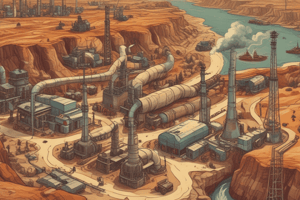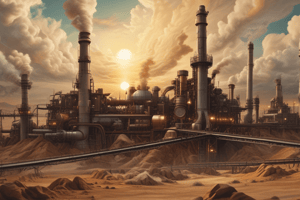Podcast
Questions and Answers
What is the main source of coal formation?
What is the main source of coal formation?
- Remains of marine plants and animals
- Remains of bacteria
- Remains of land animals
- Remains of plants, mainly ferns and swamps (correct)
What is the most common type of coal?
What is the most common type of coal?
- Bituminous (correct)
- Peat
- Lignite
- Anthracite
What is the primary use of petroleum?
What is the primary use of petroleum?
- Domestic heating and cooking
- Electricity generation
- Transportation fuels (correct)
- Industrial processes
What is a major environmental impact of burning coal and petroleum?
What is a major environmental impact of burning coal and petroleum?
What is the hardest and most pure form of coal?
What is the hardest and most pure form of coal?
What is a byproduct of petroleum extraction?
What is a byproduct of petroleum extraction?
What is a use of coal in industrial processes?
What is a use of coal in industrial processes?
What is a result of air pollution from coal and petroleum combustion?
What is a result of air pollution from coal and petroleum combustion?
Flashcards are hidden until you start studying
Study Notes
Formation of Coal and Petroleum
- Both coal and petroleum are formed from the remains of plants and animals that lived millions of years ago.
- The remains are subjected to high temperatures and pressures, causing chemical changes that transform them into fossil fuels.
Coal
- Formed from the remains of plants, mainly ferns and swamps, that accumulated in low-lying areas.
- Coal is a solid fossil fuel that is black or brown in color.
- Types of coal:
- Peat: soft, wet coal with low carbon content.
- Lignite: brown coal with higher carbon content than peat.
- Bituminous: most common type of coal, with high carbon content and high energy density.
- Anthracite: hardest and most pure form of coal, with highest carbon content and energy density.
Petroleum
- Formed from the remains of marine plants and animals, such as plankton and algae.
- Petroleum is a liquid fossil fuel that is a complex mixture of hydrocarbons.
- Types of petroleum:
- Crude oil: unrefined petroleum that is extracted from the ground.
- Natural gas: a gaseous fossil fuel that is often found with crude oil.
- Refined petroleum products:
- Gasoline
- Diesel fuel
- Jet fuel
- Lubricants
- Petrochemicals
Uses of Coal and Petroleum
- Coal:
- Electricity generation
- Industrial processes (e.g. steel production)
- Domestic heating and cooking
- Petroleum:
- Transportation fuels (gasoline, diesel, jet fuel)
- Industrial processes (e.g. manufacturing plastics)
- Electricity generation
- Domestic heating and cooking
Environmental Impact
- Burning coal and petroleum releases greenhouse gases (e.g. CO2, methane) that contribute to climate change.
- Air pollution from coal and petroleum combustion can cause respiratory problems and other health issues.
- Extraction and transportation of coal and petroleum can lead to environmental damage (e.g. oil spills, mining accidents).
Formation of Fossil Fuels
- Coal and petroleum are formed from the remains of plants and animals that lived millions of years ago, subjected to high temperatures and pressures.
Coal
- Formed from the remains of plants, mainly ferns and swamps, that accumulated in low-lying areas.
- A solid fossil fuel that is black or brown in color.
- Four types of coal, in order of increasing carbon content and energy density:
- Peat: soft, wet coal with low carbon content.
- Lignite: brown coal with higher carbon content than peat.
- Bituminous: most common type of coal, with high carbon content and high energy density.
- Anthracite: hardest and most pure form of coal, with highest carbon content and energy density.
Petroleum
- Formed from the remains of marine plants and animals, such as plankton and algae.
- A liquid fossil fuel that is a complex mixture of hydrocarbons.
- Three main types of petroleum:
- Crude oil: unrefined petroleum that is extracted from the ground.
- Natural gas: a gaseous fossil fuel that is often found with crude oil.
- Refined petroleum products, including: + Gasoline + Diesel fuel + Jet fuel + Lubricants + Petrochemicals
Uses of Coal and Petroleum
- Coal is used for:
- Electricity generation
- Industrial processes (e.g. steel production)
- Domestic heating and cooking
- Petroleum is used for:
- Transportation fuels (gasoline, diesel, jet fuel)
- Industrial processes (e.g. manufacturing plastics)
- Electricity generation
- Domestic heating and cooking
Environmental Impact
- Burning coal and petroleum releases greenhouse gases (e.g. CO2, methane) that contribute to climate change.
- Air pollution from coal and petroleum combustion can cause respiratory problems and other health issues.
- Extraction and transportation of coal and petroleum can lead to environmental damage (e.g. oil spills, mining accidents).
Studying That Suits You
Use AI to generate personalized quizzes and flashcards to suit your learning preferences.




